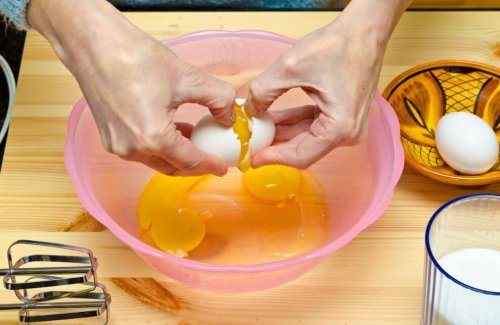High-Protein Diet: Slim Down and Gain Muscle Mass

Those who do anaerobic exercise to define their muscles know the importance of a proper diet. A high-protein diet involves eating an extreme amount of protein. This way, you’ll promote muscle gain and avoid the foods that can cause obesity. Find out how you can follow a high-protein diet.
The benefits of a high-protein diet for muscle mass
Where muscles are made mainly of protein, this type of diet promotes the effective repair of bones, muscles, skin, and hair–providing great vitality.
Another one of protein’s responsibilities in your body, is to help your organs and cells to communicate. This makes a high-protein diet beneficial for proper hormonal development.

On the other hand, protein also transports molecules such as, oxygen, which transports hemoglobin to cells.
You may have heard or read about the importance of enzymes for chemical reactions in your body? The presence of adequate amounts of protein means that enzymes can perform better.
How muscle mass increases with a high-protein diet
There aren’t many secrets when it comes to increasing muscle mass. You should exercise every day toward a specific goal. Therefore, organizing it by muscle groups can ensure that your muscle mass will increase evenly throughout your body. The use of weights and equipment can really help you to reach your goal.
As for the type of exercises needed to see results in your muscles, they should be intense. You shouldn’t do less than three sets of at least ten repetitions. In any case, five sets of ten repetitions is the daily maximum for any exercise.
A hyperproteic diet is essential for doing anaerobic exercises without weakening your body. The habit of eating protein-rich foods before and after working out will help your tissues regenerate in a timely manner.
Each muscle group that you work intensively should be given the opportunity to rest for at least two days before exercising again. Rest allows your muscle mass to increase properly without tearing, injury, or weakening. Technique and taking care of your body are essential for good results.
Begin gradually and with help
Those starting out in the fitness world should consult with expert trainers. If you overwork your body or if the exercises aren’t performed correctly, you’ll delay achieving the muscles that you want.
It’s also not worth skipping any steps. Warming up properly is crucial before you begin doing anaerobic exercise. You can choose to warm up on the elliptical or treadmill, among other methods.
Following these steps and having the patience to see results are basic conditions for gaining muscle mass with a high-protein diet.
Are high-protein diets suitable for anyone?
As with any diet, high-protein ones should be followed responsibly. Those who want to increase muscle mass and lose weight should consult with a sports nutritionist. In addition, remember that this diet suppresses fat and sugar, including fruits.
Furthermore, what you can eat in a high-protein diet are foods that contain a lot of protein. Meat in all its forms, fish, dairy products, eggs, and almost all vegetables. If you balance these ingredients correctly, the risk of losing too much weight is eliminated.

How eating extra protein can help you lose weight
Since this is a diet that completely omits fat and sugar, your body will look to restore these nutrients in another way. Your body will use sugar and fat from the areas that store the fattiest tissues. What’s more, you’ll see your weight drop thanks to this reaction, in a matter of days.
In conclusion, high-protein diets change your metabolism to increase muscle mass. What happens is that protein consumes a high percentage of your body’s calories. The more protein you consume, the better your metabolism will perform.
The trick, if you will, is to take advantage of this extra energy from the protein and increase your muscle mass through high-intensity, anaerobic exercise.
Those who do anaerobic exercise to define their muscles know the importance of a proper diet. A high-protein diet involves eating an extreme amount of protein. This way, you’ll promote muscle gain and avoid the foods that can cause obesity. Find out how you can follow a high-protein diet.
The benefits of a high-protein diet for muscle mass
Where muscles are made mainly of protein, this type of diet promotes the effective repair of bones, muscles, skin, and hair–providing great vitality.
Another one of protein’s responsibilities in your body, is to help your organs and cells to communicate. This makes a high-protein diet beneficial for proper hormonal development.

On the other hand, protein also transports molecules such as, oxygen, which transports hemoglobin to cells.
You may have heard or read about the importance of enzymes for chemical reactions in your body? The presence of adequate amounts of protein means that enzymes can perform better.
How muscle mass increases with a high-protein diet
There aren’t many secrets when it comes to increasing muscle mass. You should exercise every day toward a specific goal. Therefore, organizing it by muscle groups can ensure that your muscle mass will increase evenly throughout your body. The use of weights and equipment can really help you to reach your goal.
As for the type of exercises needed to see results in your muscles, they should be intense. You shouldn’t do less than three sets of at least ten repetitions. In any case, five sets of ten repetitions is the daily maximum for any exercise.
A hyperproteic diet is essential for doing anaerobic exercises without weakening your body. The habit of eating protein-rich foods before and after working out will help your tissues regenerate in a timely manner.
Each muscle group that you work intensively should be given the opportunity to rest for at least two days before exercising again. Rest allows your muscle mass to increase properly without tearing, injury, or weakening. Technique and taking care of your body are essential for good results.
Begin gradually and with help
Those starting out in the fitness world should consult with expert trainers. If you overwork your body or if the exercises aren’t performed correctly, you’ll delay achieving the muscles that you want.
It’s also not worth skipping any steps. Warming up properly is crucial before you begin doing anaerobic exercise. You can choose to warm up on the elliptical or treadmill, among other methods.
Following these steps and having the patience to see results are basic conditions for gaining muscle mass with a high-protein diet.
Are high-protein diets suitable for anyone?
As with any diet, high-protein ones should be followed responsibly. Those who want to increase muscle mass and lose weight should consult with a sports nutritionist. In addition, remember that this diet suppresses fat and sugar, including fruits.
Furthermore, what you can eat in a high-protein diet are foods that contain a lot of protein. Meat in all its forms, fish, dairy products, eggs, and almost all vegetables. If you balance these ingredients correctly, the risk of losing too much weight is eliminated.

How eating extra protein can help you lose weight
Since this is a diet that completely omits fat and sugar, your body will look to restore these nutrients in another way. Your body will use sugar and fat from the areas that store the fattiest tissues. What’s more, you’ll see your weight drop thanks to this reaction, in a matter of days.
In conclusion, high-protein diets change your metabolism to increase muscle mass. What happens is that protein consumes a high percentage of your body’s calories. The more protein you consume, the better your metabolism will perform.
The trick, if you will, is to take advantage of this extra energy from the protein and increase your muscle mass through high-intensity, anaerobic exercise.
All cited sources were thoroughly reviewed by our team to ensure their quality, reliability, currency, and validity. The bibliography of this article was considered reliable and of academic or scientific accuracy.
- Nascimento da Silva, Z., Azevedo de Jesuz, V., De Salvo Castro, E., Soares da Costa, C. A., Teles Boaventura, G., & Blondet de Azeredo, V. (2014). Effect of the “protein diet” and bone tissue. Nutrición Hospitalaria. https://doi.org/10.3305/nh.2014.29.1.7000
- Palomba, S., Giallauria, F., Falbo, a, Russo, T., Oppedisano, R., Tolino, a, … Orio, F. (2008). Structured exercise training programme versus hypocaloric hyperproteic diet in obese polycystic ovary syndrome patients with anovulatory infertility: a 24-week pilot study. Human Reproduction (Oxford, England). https://doi.org/10.1093/humrep/dem391
- Rugeles, S., Villarraga-Angulo, L. G., Ariza-Gutiérrez, A., Chaverra-Kornerup, S., Lasalvia, P., & Rosselli, D. (2016). High-protein hypocaloric vs normocaloric enteral nutrition in critically ill patients: A randomized clinical trial. Journal of Critical Care. https://doi.org/10.1016/j.jcrc.2016.05.004
- Larsen, T. M., Dalskov, S.-M., van Baak, M., Jebb, S. A., Papadaki, A., Pfeiffer, A. F. H., … Astrup, A. (2010). Diets with High or Low Protein Content and Glycemic Index for Weight-Loss Maintenance. New England Journal of Medicine. https://doi.org/10.1056/NEJMoa1007137
This text is provided for informational purposes only and does not replace consultation with a professional. If in doubt, consult your specialist.








